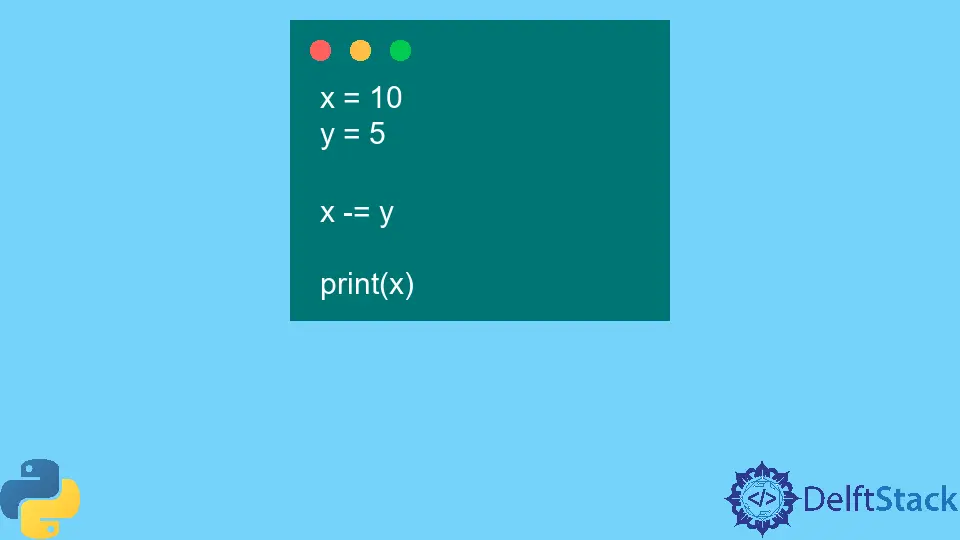Assignment Operators in Python
- What is the -= Operator?
- Using -= in Loops
- Using -= with Lists
- Practical Example: Decrementing Scores
- Conclusion
- FAQ

Python is a versatile programming language that allows developers to perform a variety of operations efficiently. One of the essential features of Python is its assignment operators, which enable you to modify variable values conveniently.
In this tutorial, we will focus specifically on the -= assignment operator, a shorthand for subtracting a value from an existing variable. Understanding how to use this operator can help streamline your code and make it more readable. Whether you’re a beginner or an experienced programmer, mastering assignment operators can significantly enhance your coding skills. Let’s dive into the details of the -= operator and see how it works through practical examples.
What is the -= Operator?
The -= operator is a compound assignment operator in Python that subtracts a specified value from a variable and then assigns the result back to that variable. It’s a shorthand way of writing an operation that would otherwise require more code. Instead of writing x = x - value, you can simply write x -= value. This not only saves you keystrokes but also makes your code cleaner and easier to read.
Let’s look at a simple example to illustrate this concept.
x = 10
x -= 3
print(x)
Output:
7
In this example, we start with a variable x set to 10. When we apply the -= operator with a value of 3, it subtracts 3 from 10 and assigns the result back to x, resulting in a final value of 7. This simple operation showcases how the -= operator can make your code more concise.
Using -= in Loops
The -= operator is particularly useful in loops, where you might need to decrement a variable multiple times. Let’s explore how this operator can be applied in a loop scenario.
count = 5
while count > 0:
print(count)
count -= 1
Output:
5
4
3
2
1
In this code, we initialize count to 5 and use a while loop to print its value until it reaches zero. Each iteration of the loop decreases count by 1 using the -= operator. This results in a clean and efficient way to decrement the variable without cluttering the loop with additional syntax. The use of -= here not only simplifies the code but also enhances its readability.
Using -= with Lists
Another interesting application of the -= operator is with lists. You can use it to modify elements in a list, especially when you want to decrement values stored in the list. Let’s see how this can be done.
numbers = [10, 20, 30, 40]
for i in range(len(numbers)):
numbers[i] -= 5
print(numbers)
Output:
[5, 15, 25, 35]
In this example, we have a list of numbers. By iterating through the list using a for loop, we apply the -= operator to each element. This operation subtracts 5 from each number in the list, resulting in a new list with the updated values. This showcases the versatility of the -= operator, allowing you to perform batch updates on data structures efficiently.
Practical Example: Decrementing Scores
Let’s consider a practical example where you might want to use the -= operator to manage scores in a game. This can help illustrate its utility in real-world applications.
player_score = 100
penalties = [5, 10, 15]
for penalty in penalties:
player_score -= penalty
print(player_score)
Output:
70
In this scenario, we start with a player score of 100. We then have a list of penalties that need to be deducted from the score. By using the -= operator in a loop, we efficiently subtract each penalty from the player’s score. The final output shows that after applying all penalties, the player’s score is reduced to 70. This example highlights how the -= operator can be integral to managing dynamic data and states in applications.
Conclusion
The -= assignment operator in Python is a powerful tool that simplifies the process of subtracting values from variables. Whether you’re working with simple variables, loops, or more complex data structures like lists, the -= operator can help you write cleaner and more efficient code. By mastering this operator, you can enhance your programming skills and improve the readability of your code. As you continue your journey in Python programming, remember that understanding these nuances can lead to better coding practices and more robust applications.
FAQ
-
What is the purpose of the -= operator in Python?
The-=operator subtracts a value from a variable and assigns the result back to that variable, allowing for more concise code. -
Can I use the -= operator with strings in Python?
No, the-=operator is not applicable to strings, as strings are immutable in Python. -
Are there other assignment operators in Python?
Yes, Python has several other assignment operators, including+=,*=,/=, and%=. -
How does the -= operator improve code readability?
By reducing the amount of code needed to perform a subtraction operation, the-=operator makes the intent clearer and the code cleaner. -
Can I use the -= operator with lists?
Yes, you can use the-=operator to modify elements in a list, as demonstrated in the examples above.
Lakshay Kapoor is a final year B.Tech Computer Science student at Amity University Noida. He is familiar with programming languages and their real-world applications (Python/R/C++). Deeply interested in the area of Data Sciences and Machine Learning.
LinkedIn